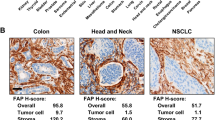Abstract
Purpose
Matrix metalloproteinases (MMPs), a group of more than 20 zinc-containing endopeptidases, are upregulated in many diseases, but several attempts to use radiolabelled MMP inhibitors for imaging tumours have proved unsuccessful in mouse models, possibly due to the limited specificity of these agents or their unfavourable pharmacokinetic profiles. In principle, radiolabelled monoclonal antibodies could be considered for the selective targeting and imaging of individual MMPs.
Methods
We cloned, produced and characterized high-affinity monoclonal antibodies specific to murine MMP-1A, MMP-2 and MMP-3 in SIP (small immunoprotein) miniantibody format using biochemical and immunochemical methods. We also performed comparative biodistribution analysis of their tumour-targeting properties at three time points (3 h, 24 h, 48 h) in mice bearing subcutaneous F9 tumours using radioiodinated protein preparations. The clinical stage L19 antibody, specific to the alternatively spliced EDB domain of fibronectin, was used as reference tumour-targeting agent for in vivo studies.
Results
All anti-MMP antibodies and SIP(L19) strongly stained sections of F9 tumours when assessed by immunofluorescence methods. In biodistribution experiments, SIP(SP3), specific to MMP-3, selectively accumulated at the tumour site 24 and 48 h after intravenous injection, but was rapidly cleared from other organs. By contrast, SIP(SP1) and SIP(SP2), specific to MMP-1A and MMP-2, showed no preferential accumulation at the tumour site.
Conclusion
Antibodies specific to MMP-3 may serve as vehicles for the efficient and selective delivery of imaging agents or therapeutic molecules to sites of disease.


Similar content being viewed by others
References
Carter PJ. Potent antibody therapeutics by design. Nat Rev Immunol 2006;6:343–57.
Neri D, Bicknell R. Tumour vascular targeting. Nat Rev Cancer 2005;5:436–46.
Overall CM, Kleifeld O. Tumour microenvironment – opinion: validating matrix metalloproteinases as drug targets and anti-targets for cancer therapy. Nat Rev Cancer 2006;6:227–39.
Pfaffen S, Hemmerle T, Weber M, Neri D. Isolation and characterization of human monoclonal antibodies specific to MMP-1A, MMP-2 and MMP-3. Exp Cell Res 2010;316:836–47.
Scherer RL, McIntyre JO, Matrisian LM. Imaging matrix metalloproteinases in cancer. Cancer Metastasis Rev 2008;27:679–90.
Borsi L, Balza E, Bestagno M, Castellani P, Carnemolla B, Biro A, et al. Selective targeting of tumoral vasculature: comparison of different formats of an antibody (L19) to the ED-B domain of fibronectin. Int J Cancer 2002;102:75–85.
Villa A, Trachsel E, Kaspar M, Schliemann C, Sommavilla R, Rybak JN, et al. A high-affinity human monoclonal antibody specific to the alternatively spliced EDA domain of fibronectin efficiently targets tumor neo-vasculature in vivo. Int J Cancer 2008;122:2405–13.
Zuberbühler K, Palumbo A, Bacci C, Giovannoni L, Sommavilla R, Kaspar M, et al. A general method for the selection of high-level scFv and IgG antibody expression by stably transfected mammalian cells. Protein Eng Des Sel 2009;22:169–74.
Temma T, Sano K, Kuge Y, Kamihashi J, Takai N, Ogawa Y, et al. Development of a radiolabeled probe for detecting membrane type-1 matrix metalloproteinase on malignant tumors. Biol Pharm Bull 2009;32:1272–77.
Overall CM, Lopez-Otin C. Strategies for MMP inhibition in cancer: innovations for the post-trial era. Nat Rev Cancer 2002;2:657–72.
Acknowledgments
The SIP(L19) antibody used in this study was a kind gift from Alessandro Palumbo (ETH Zurich, Switzerland).
Financial support from ETH Zürich (ETHIRA grant), the Swiss National Science Foundation (grant 3100A0-105919/1), the Swiss Cancer League (Robert-Wenner Award), the SWISSBRIDGE-Stammbach Foundation and European Union Projects IMMUNO-PDT (grant LSHC-CT-2006-037489), DIANA (grant LSHB-CT-2006-037681) and ADAMANT (HEALT-F2-2008-201342) is gratefully acknowledged.
Author information
Authors and Affiliations
Corresponding author
Electronic supplementary material
Below are the links to the electronic supplementary material.
Fig. S1
SDS-PAGE analysis of SIP(SP1) before and after treatment with PNGase F to deglycosylate the SIP antibody (m molecular weight marker, R SIP antibodies under reducing conditions, NR SIP antibodies under nonreducing conditions, SP1 dg, deglycosylated SIP(SP1), +ctrl an unglycosylated SIP antibody) (GIF 34 kb)
Fig. S2
Confocal laser scanning microscopy analysis performed on cryosections of murine F9 teratocarcinoma. MMP-1A, MMP-2, MMP-3 and extradomain B of fibronectin (EDB) are stained in green, the cytoskeleton is stained in red, and cell nuclei are stained in blue (scale bars 20 µm) (GIF 500 kb)
Fig. S3
Blood clearance comparison of SIP antibodies containing either a DPL-16 (F16, SP1, SP2, P12 and G11) or a DPK-22 light chain (SP3, L19, F8). For all antibodies, %ID/g values at time 0 were set equal to 40%, corresponding to a blood volume of 2.5 ml. The data points were calculated as average of the individual %ID/g values for the SIP antibodies in the two groups. The corresponding biodistribution data for the individual SIPs can be found in the following articles: Brack SS, Silacci M, Birchler M, Neri D. Clin Cancer Res 2006;12:3200–8; Borsi L, Balza E, Bestagno M, et al. Int J Cancer 2002;102:75–85; El-Emir E, Dearling JL, Huhalov A, et al. Br J Cancer 2007; 96:1862–70; Schliemann C, Palumbo A, Zuberbühler K, et al. Blood 2008;113:2275–83; Silacci M, Brack SS, Späth N, et al. Protein Eng Des Sel 2006;19:471–8; Villa A, Trachsel E, Kaspar M, et al. Int J Cancer 2008;122:2405–13 (GIF 16 kb)
Fig. S4
Biodistribution (a) and urine analysis (b) of 125I-labelled SIP(SP2), SIP(SP3) and SIP(L19) 30 minutes after intravenous injection. Each value was derived from an average of two animals (GIF 37 kb)
Fig. S5
BIAcore sensograms of murine blood serum run onto biosensor chips coated with SIP(SP1), SIP(SP2) and SIP(SP3). As positive control (+ctrl) for SIP immunodetection on BIAcore, rabbit anti-human IgE was used. As negative control (-ctrl), saline solution was flushed over the SIP-coated chips (GIF 42 kb)
Rights and permissions
About this article
Cite this article
Pfaffen, S., Frey, K., Stutz, I. et al. Tumour-targeting properties of antibodies specific to MMP-1A, MMP-2 and MMP-3. Eur J Nucl Med Mol Imaging 37, 1559–1565 (2010). https://doi.org/10.1007/s00259-010-1446-9
Received:
Accepted:
Published:
Issue Date:
DOI: https://doi.org/10.1007/s00259-010-1446-9




